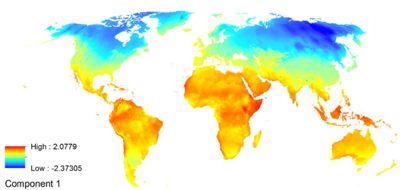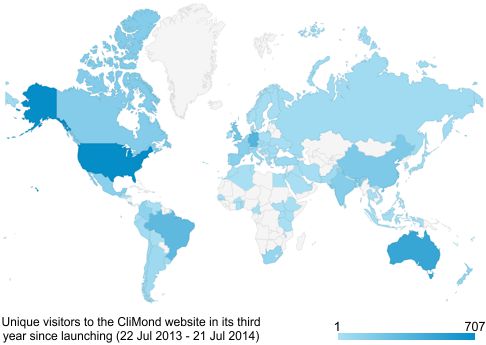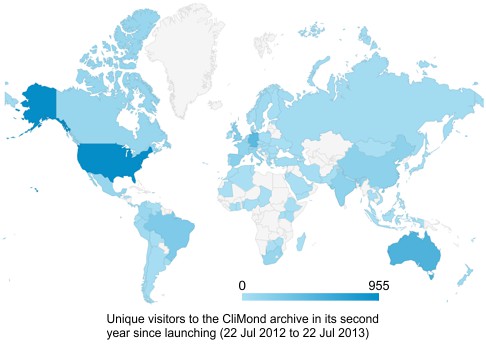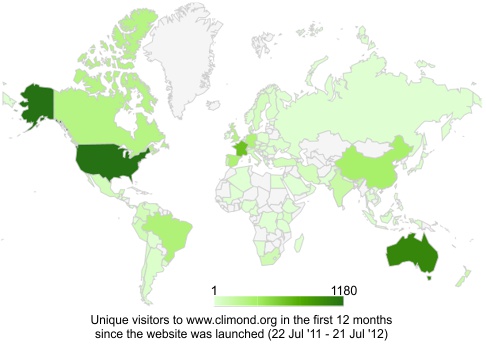Updates
26 November 2014: The ExDet tool Version 1.1 released

We are pleased to announce the release of an updated version of the ExDet tool. More functionality for checking the integrity of the covariate layers has been our primary focus in this revision, with the inclusion of the 'Data Checker' feature. Please read the
ExDet changelog for further details on other changes.
09 September 2014: CliMond Version 1.2 goes live

We are pleased to announce the release of the CliMond V1.2 data products. The new Bioclim variables, Bio36 to Bio40 are now included. Please read the CliMond
changelog for further details.
28 August 2014: New Bioclim variables: Bio36 to Bio40

A new manuscript recently published in
Methods in Ecology and Evolution describes five new Bioclim variables. Bio36 to 40, derived from a principal components analysis of the first 35 Bioclim variables, have been added to the
Bioclim register.
The newly created variables are described in full in the following paper:
• Kriticos D.J., Jarošik V. and Ota N. (2014) Extending the suite of Bioclim variables: a proposed registry system and case study using principal components analysis.
Methods in Ecology and Evolution, Online Early, DOI: 10.1111/2041-210X.12244. [
Download]
24 August 2014: The Bioclim registry

Referring to each Bioclim variable by its Bio number has become a standard reference in the literature. Previously, the ANUCLIM manual was a
de facto repository for the variables, containing descriptions. A new manuscript proposes that the CliMond website take over the repository role, describing each variable, and where suitable, making a copy of the variable available within the CliMond archive. We encourage researchers to identify additional Bioclimatic covariates to extend the suite further.
The Bioclim registry is
available here and the principles for this registry of global variables are described in full in the following paper:
• Kriticos D.J., Jarošik V. and Ota N. (2014) Extending the suite of Bioclim variables: a proposed registry system and case study using principal components analysis.
Methods in Ecology and Evolution, Online Early, DOI: 10.1111/2041-210X.12244. [
Download]
22 July 2014: CliMond: a summary of the third year

In the third year of the CliMond website, we have had over
21000 page views, this year being from over
4500 unique visits from more than
100 countries.
The United States, Australia, Germany and Brazil remained the top countries of origin for site visitors. There was a 112% increase in visits from Argentina and a 75% increase in visits from Chile, leading a strong pulse of activity in South American countries over the past 12 months.
We now have over
1350 registered users and these registered users have
downloaded over 2400 climate data files in the past 12 months. The
journal article describing the creation of the data products has now been cited
84 times.
21 April 2014: The EXtrapolation DETection (ExDet) tool

Correlative species distribution models (SDMs) often involve some degree of projection into novel covariate space. Most methods for identifying this extrapolation focus on the range of each model covariate individually. However, extrapolation can occur that is well within the range of univariate variation but which exhibits novel combinations between covariates. The ExDet tool, based on the Mahalanobis distance, measures the similarity between the reference and projection domains by accounting for both the deviation from the mean and the correlation between variables. The tool also provides an assessment of the most influential variables leading to dissimilarity. The ExDet tool is an a more informative way for exploring novelty for and interpreting projections from correlative SDMs. The tool is
available here on the CliMond archive for free download as standalone software and is described in full in the following paper:
• Mesgaran, M.B., Cousens, R.D. & Webber, B.L. (2014) Here be dragons: a tool for quantifying novelty due to covariate range and correlation change when projecting species distribution models.
Diversity and Distributions,
20: 1147–1159, DOI: 10.1111/ddi.12209. [
Download]
22 July 2013: CliMond: a summary of the second year

In the second year of the CliMond website, we had over
21000 page views from over
4800 unique visitors from more than
90 countries. The United States, Australia, Germany and Brazil were the top countries of origin for site visitors.
We now have over
940 registered users and these registered users have downloaded over
2300 climate data files in the past 12 months.
The
journal article describing the creation of the data products was the 9th most downloaded paper in 2012 for
Methods in Ecology and Evolution and has now been
cited 39 times.
22 July 2012: CliMond: a summary of the first 12 months
In the first year since the launch of the CliMond website in July 2011, we have had
over
40000 page views from over
6000
unique visitors from more than
86 countries. Of these visitors,
over
520 have registered as official users and these registered users have
downloaded over
7200 climate data files. In the last two months alone, over 750 data files have been downloaded, a sign of increasing popularity for the CliMond products. While such statistics are more representative of future scientific impact as they end up being used to underpin other modelling research, the manuscript describing the creation of the data products has already attracted
12 citations
that we are aware of:

• Macfadyen S.
et al. (2012) Modelling the geographical range of a species with variable life-history.
PLoS ONE, 7, e40313. [
Download]
• Faulkes Z.
et al. (2012) Do Marmorkrebs,
Procambarus fallax f.
virginalis, threaten freshwater Japanese ecosystems?
Aquatic Biosystems, 8, 13. [
Download]
• Eyre D.
et al. (2012) Rating and mapping the suitability of the climate for pest risk analysis.
EPPO Bulletin, 42, 48-55. [
Download]
• Kriticos D.J.
et al. (2012) Estimating the global area of potential establishment for the western corn rootworm (
Diabrotica virgiferavirgifera) under rain-fed and irrigated agriculture.
EPPO Bulletin, 42, 56-64. [
Download]
• Tellería J.L.
et al. (2012) Use of ring recoveries to predict habitat suitability in small passerines.
Diversity and Distributions, (online early). [
Download]
• Zhu G.
et al. (2012) Potential geographic distribution of Brown Marmorated Stink Bug invasion (
Halyomorpha halys).
PLoS ONE, 7, e31246. [
Download]
• Michael P.J.
et al. (2012) The current and future projected distribution of
Solanum hoplopetalum (Solanaceae): an indigenous weed of the south-western Australian grain belt.
Australian Journal of Botany, 60, 128-135. [
Download]
• Taylor S.
et al. (2012) Climate change and the potential distribution of an invasive shrub,
Lantana camara L.
PLoS ONE, 7, e35565. [
Download]
• Watt M.S.
et al. (2011) Climate change and the potential global distribution of Serrated Tussock (
Nassella trichotoma).
Weed Science, 59, 538-545. [
Download]
• Moore J.L.
et al. (2011) Contain or eradicate? Optimizing the management goal for Australian acacia invasions in the face of uncertainty.
Diversity and Distributions, 17, 1047-1059. [
Download]
• Thompson G.D.
et al. (2011) Predicting sub-specific identity of invasions using distribution models:
Acacia saligna as an example.
Diversity and Distributions, 17, 1001-1014. [
Download]
• Webber B.L.
et al. (2011) Modelling horses for novel climate courses: insights from projecting potential distributions of native and alien Australian acacias with correlative and mechanistic models.
Diversity and Distributions, 17, 978-1000. [
Download]
02 February 2012: CliMond manuscript published in Methods in Ecology and Evolution
The CliMond manuscript has been published in Volume 3, Issue 1 of the journal
Methods in Ecology and Evolution on pages 53-64. As this is part of the first issue of 2012, the paper is free to download! To download the paper, please
click here.
31 January 2012: CliMond Version 1.1 goes live
We are pleased to announce the release of the CliMond V1.1 data products. Further future climate scenarios (2090 and 2100) as well as minor adjustments to other
data products have been made. Please read the CliMond
changelog for further details.
24 August 2011: The first citations for CliMond
The first publications using the CliMond climate data products were recently published in the
September 2011 issue (Volume 17, Issue 5) of Diversity and Distributions. This special issue entitled "
Human-mediated introductions of Australian
acacias - a global experiment in biogeography" is open access for
free downloads. CliMond data products feature in three papers using three bioclimatic modelling techniques: M
AXE
NT,
Boosted Regression Trees and CLIMEX:
• Webber B.L., Yates C.J., Le Maitre D.C., Scott J.K., Kriticos D.J., Ota N., McNeill A., Le Roux J.J. & Midgely G.F. (2011) Modelling horses for novel climate
courses: insights from projecting potential distributions of native and alien Australian acacias with correlative and mechanistic models.
Diversity and Distributions,
17, 978-1000. [
Download]
• Thompson G.D., Robertson M.P., Webber B.L., Richardson D.M., Le Roux J.J. & Wilson J.R.U. (2011) Predicting sub-specific identity of invasions using distribution
models:
Acacia saligna as an example.
Diversity and Distributions, 17, 1001-1014. [
Download]
• Moore J.L., Runge M.C., Webber B.L. & Wilson J.R.U. (2011) Contain or eradicate? Optimizing the management goal for Australian acacia invasions in the face of
uncertainty.
Diversity and Distributions, 17, 1047-1059. [
Download]
19 August 2011: Köppen (1936) publication revived
In collaboration with
Borntraeger Science Publishers, we are delighted to be able to make available
a PDF of the original manuscript in which Wladimir Köppen (Graz, Austria) and Rudolf Geiger (Munich, Germany) published their climate classification scheme. Entitled
"The Geographic System of Climates", the PDF is Volume 1 Part C in the Handbuch der Klimatologie, a 5 volume series published between 1930 and 1938. In this work
published in 1936, Köppen devises the climate classification that is later to be known as the Köppen-Geiger system of climate classification. Download the PDF from
the
resources page.
22 July 2011: CliMond website goes live
To coincide with the ‘online early’ publication of the CliMond manuscript at Methods in Ecology and Evolution, the associated CliMond website went live today.
10 May 2011: Manuscript accepted
The manuscript describing the creation and generation of the CliMond V1.0 climate data base was accepted for publication by Methods in Ecology and Evolution.
